Everest Base Camp Trek Tips
For a joyful and responsible journey in this breathtaking Himalayan terrain, respecting local culture and following "Leave No Trace" ideals are equally important.
For a joyful and responsible journey in this breathtaking Himalayan terrain, respecting local culture and following "Leave No Trace" ideals are equally important.

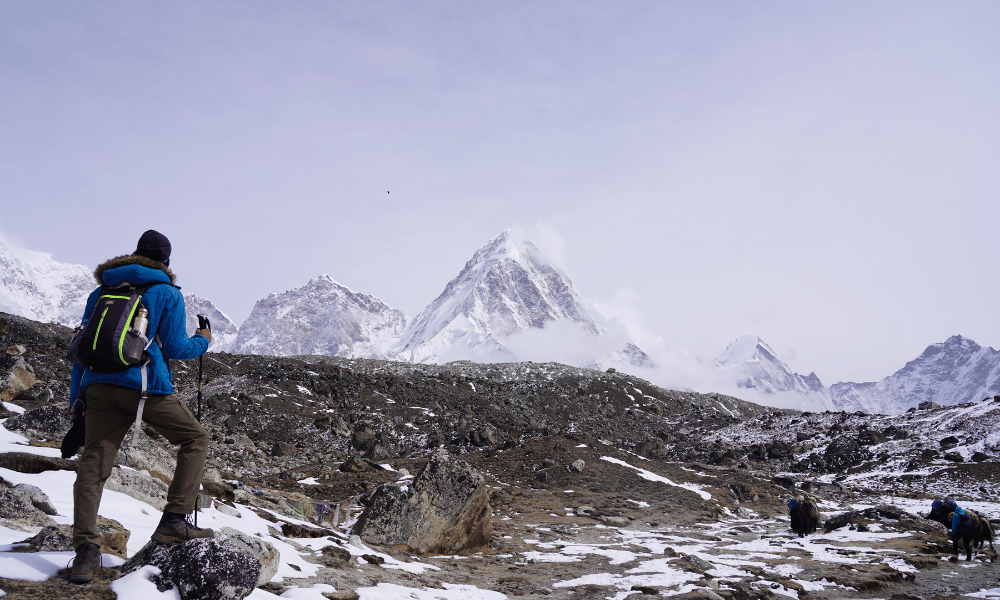
Welcome to the Everest Base Camp (EBC) Trek, life's greatest experience! This trip, which is regarded as one of the world's most famous adventures, is a once-in-a-lifetime opportunity that takes you deep into the Himalayas and offers unparalleled panoramic views and an in-depth knowledge of the region's cultural diversity.
The Everest Base Camp, which is located at a dizzying elevation of around 5,364 meters (17,598 feet), serves as the starting point for anybody who aspires to climb Mount Everest, the highest mountain in the world. However, the Base Camp itself is a noteworthy accomplishment and no little endeavor.
The journey to Everest Base Camp typically takes two weeks, allowing you plenty of time to take in the breathtaking scenery and acclimate to the high altitude. Given that the route entails many days of hiking on rocky terrains and steep inclines, it is a difficult undertaking that calls for energy and resolve.
Although the breathtaking landscape along the route and the sense of success you'll experience when reaching the base of the world's tallest peak are unparalleled. It must be a magnificent experience to wander among towering peaks, traverse swaying suspension bridges, navigate through lush forests, and come across unusual flora and creatures.
We'll be providing you with important advice and insights in this complete guide to help you get ready for this amazing voyage. By the finish, you'll fully comprehend what to anticipate and how to get ready for a fruitful, pleasurable, and secure trek to Everest Base Camp. Put on your virtual hiking boots, and let's get out on this fascinating excursion!
A successful and enjoyable journey to Everest Base Camp depends on preparation. This section of the guide offers important advice on how to properly get ready for this difficult expedition. To make sure you are both physically and psychologically prepared for the arduous journey to Everest Base Camp, all of these pre-trek preparation activities are essential. Your trekking experience may be greatly improved by careful planning, making it gratifying and memorable for all the right reasons.
An excellent degree of physical fitness is necessary for the challenging Everest Base Camp Trek. It's important to be in a state where you can easily walk for many hours each day for a number of consecutive days, frequently on steep, rocky terrain at high elevations, even if you don't have to be an outstanding athlete.

Here are some recommended exercises and routines to help prepare your body for the challenges of the trek:
Cardiovascular Training
Cardiovascular or aerobic fitness is critical for a trek like this, as you need to ensure your body can efficiently use oxygen at high altitudes. Focus on exercises that raise your heart rate and increase lung capacity.
Running or Jogging: Aim for a 5km to 10km run at least three times a week. Gradually increase the distance over time to improve your endurance.
Cycling or Swimming: These exercises are excellent alternatives for those who find running hard on the joints. They are great for improving heart and lung health while also building your stamina.
High-Intensity Interval Training (HIIT): This involves short bursts of intense exercise with recovery periods, which is perfect for replicating the trek's strain where you have steep climbs followed by easier periods.
The EBC trek involves long ascents and descents, so your legs, core, and back need to be strong. Incorporate strength training exercises into your routine two to three times a week.
Leg exercises: Squats, lunges, and calf raises are fantastic for building leg strength.
Core exercises: A strong core can help improve balance and stability while trekking. Incorporate exercises such as planks, sit-ups, and Russian twists.
Back exercises: Strengthening your back is crucial, especially if you're planning to carry your backpack. Try exercises like back extensions, rows, and deadlifts.
Last but not least, acclimate your body to long-distance walking, ideally on steep terrain. To mimic the circumstances of a journey, try doing long treks while wearing a laden backpack. By doing this, you may prepare your body for the journey and test your trekking equipment.
Do not forget that it is advised to begin your fitness regimen at least three months before to your expedition. To prevent damage, start out slowly and gradually up the intensity while paying attention to your body. Before beginning any new fitness program, it's wise to speak with a medical expert or certified fitness instructor. A successful and enjoyable trek to Everest Base Camp requires preparation.
Dealing with the high altitude is one of the biggest difficulties of the Everest Base Camp Trek. The air is thinner as you ascend, which means there is less oxygen available. Acute Mountain Sickness (AMS), or more often known as altitude sickness, may result from this.
Altitude sickness symptoms might include headaches, nausea, vertigo, exhaustion, and shortness of breath. High Altitude Cerebral Edema (HACE) and High Altitude Pulmonary Edema (HAPE), both of which can be fatal, can develop if the illness is not treated.
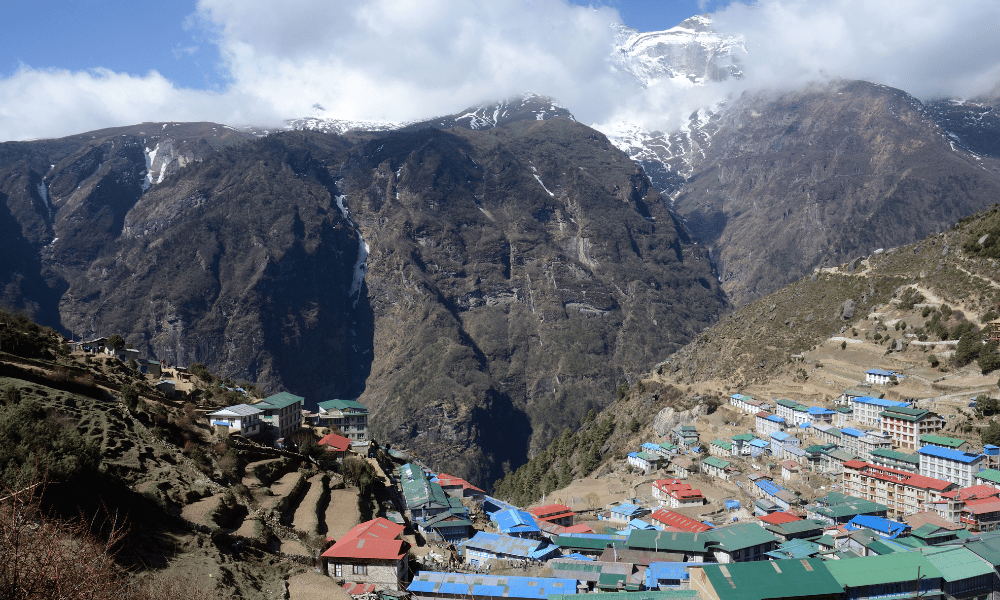
Your trekking plan must include acclimatization days in order to reduce the danger of altitude sickness. On these days, you either stay put or do short walks up to higher elevations, but you return to the lower elevation to sleep. In order to promote acclimatization during high altitude trekking, the maxim "Climb high, sleep low" is frequently utilized.
An useful read: Everest Base Camp Trek Itinerary
Here are some tips to aid acclimatization:
Acclimatization Hikes: On acclimatization days, go for short hikes to a higher altitude then descend back to sleep. This gives your body a chance to experience the thinner air but also recover when you descend.
Stay Hydrated: Drink plenty of fluids. Dehydration can exacerbate symptoms of altitude sickness.
Avoid Alcohol and Smoking: Both can interfere with your body's acclimatization process and increase the risk of AMS.
Eat Carbohydrate-rich Foods: Carbohydrates are easier to break down and use in conditions of lower oxygen, so consuming them can help your body acclimate.
Slow and Steady: Maintain a slow and steady pace while trekking. Over-exertion can increase the chances of altitude sickness.
Medication: Speak to your doctor before you leave about medication that can help prevent AMS. Acetazolamide (Diamox) is commonly used, but it's crucial to discuss potential side effects and benefits with a healthcare professional.
Keep in mind that acclimatization differs from person to person and is not largely influenced by physical fitness. Don't force yourself to keep up with others; rather, pay attention to your body. If you get altitude sickness symptoms, descend right away and get help. According to the proverb, "It's better to miss a day on the mountain than a year in the hospital." Your wellbeing and security should always come first.
The appropriate equipment is essential when it comes to preparing for your Everest Base Camp expedition. While it's important to pack as little as possible, you also need to make sure you have everything you need to withstand the rigors of the walk. You must include the following necessities on your packing list:
Trekking Boots: A good pair of waterproof and comfortable trekking boots is a must. They should be well broken-in before the trek to avoid blisters.
Clothing Layers: Temperatures can vary dramatically throughout the day, so dressing in layers is advised. Include thermal base layers, trekking shirts and trousers, a fleece jacket, a down jacket for colder temperatures, and waterproof rain gear.
Headwear: A sun hat or cap for sunny days and a beanie or headband for colder weather are necessary. They protect you from the sun and keep you warm when temperatures drop.
Sunglasses and Sunscreen: High-altitude sun can be intense, and the reflection off the snow can be harmful to your eyes and skin. A good pair of UV-protected sunglasses and high SPF sunscreen are essential.
Hydration Equipment: Carry a durable water bottle or hydration bladder. Staying hydrated is crucial in high altitude.
Medication: Bring personal medications and any prescribed altitude sickness medication. Also include any specific medication you may need for stomach upsets or travel sickness.
First-Aid Kit: Include band-aids, antiseptic wipes, tweezers, medical tape, pain relief tablets, and rehydration salts.
Water Purification Tablets: To ensure you have safe drinking water throughout the trek, pack water purification tablets or a water filtration device.
Hand Sanitizers and Wet Wipes: These are handy for personal hygiene, especially since hot showers are a rarity on the trail.
Insulated Gloves: Your hands can get very cold, particularly during early mornings and nights. Insulated, waterproof gloves are a must.
Trekking Poles: These are a lifesaver when going downhill or uphill on rough terrain. They help maintain balance and reduce strain on your joints.
Sleeping Bag: Most teahouses provide blankets, but having a good quality sleeping bag for colder nights is advisable.
Snacks: Energy bars, dried fruits, nuts, and chocolates can be useful for quick energy boosts during the trek.
Keep in mind that your health, safety, and comfort come first. Being prepared for a variety of weather situations and probable health difficulties requires strategic packing. Last but not least, always pack with the intention of leaving no trace in order to protect the stunning Everest region for future generations.
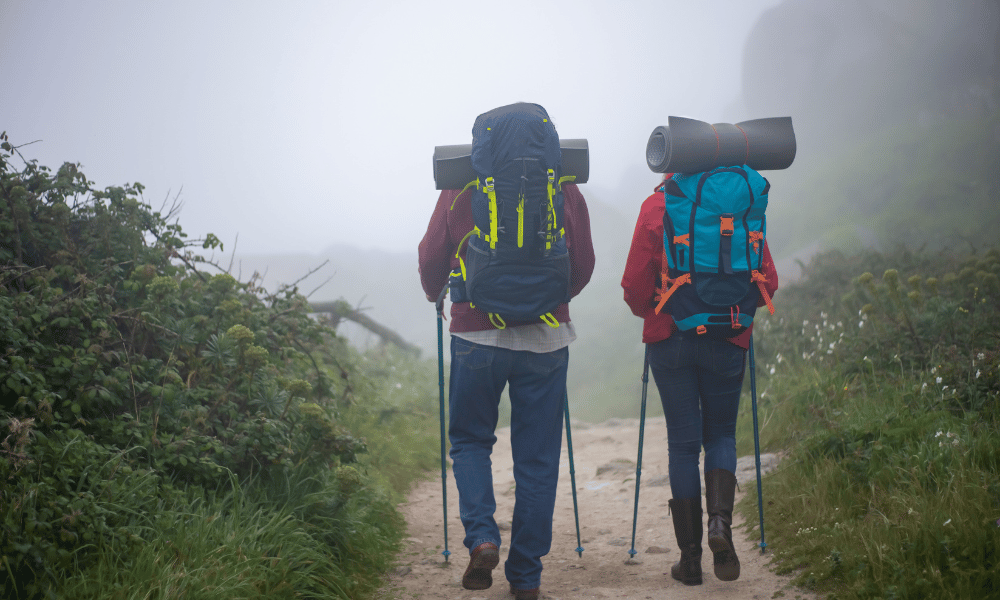
Useful Read: Everest Base Camp Trek Packing List Suggestion
There is much more to the trip to Everest Base Camp than just the strenuous physical activity. On the trek, one learns how to manage their health, pace themselves, use native porters and guides, and maintain correct water and nourishment. To prevent altitude sickness and guarantee a successful journey, it's essential to stay hydrated, eat well, and keep at a slow, steady pace. Hiring local porters and guides benefits the community's economy while also enhancing the trekking experience because of their vital help and local expertise. It's important to recognize the signs of altitude sickness and know how to react to them. You should also have full travel insurance to cover unforeseen circumstances. For treating minor injuries or illnesses, it's equally crucial to have a first aid bag and some needed medications. To guarantee a good and enjoyable trip, trekkers must adhere to the "Leave No Trace" philosophy, protect the environment, and respect local customs and traditions. The walk is a test of stamina and commitment, but if approached correctly, it can be a profoundly gratifying and drastically altering experience.
It's important to take care of your diet and hydration throughout the Everest Base Camp Trek. Due to the physical exercise and high altitude, your body is under greater stress than usual and need a regular supply of fluids and meals that are high in energy.
By being well-hydrated, you may avoid getting altitude sickness, improve digestion, and keep your energy levels high. Aim to consume at least 3 to 4 liters of water each day, and more if necessary. Keep in mind that you are already slightly dehydrated if you feel thirsty.
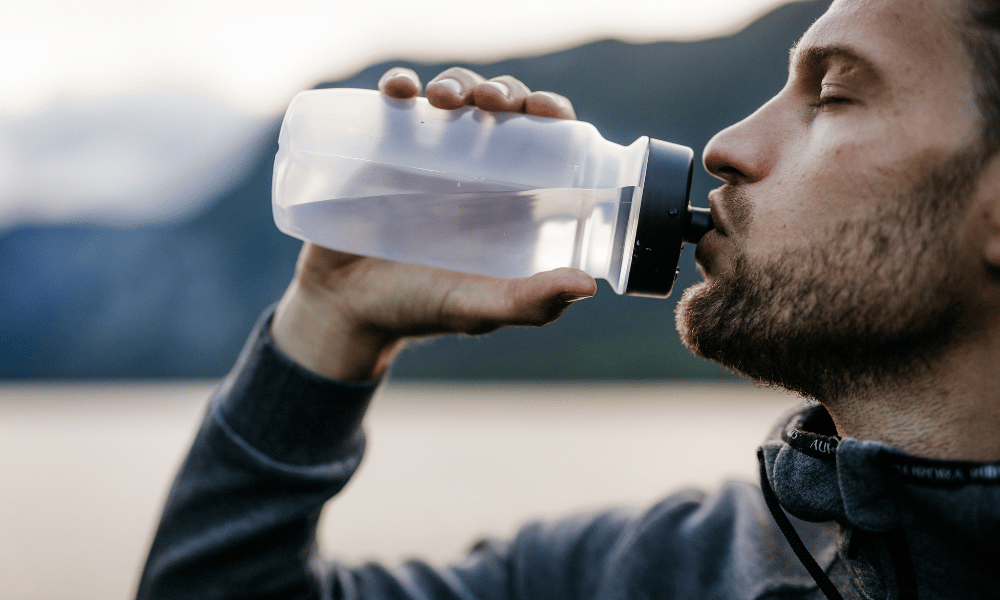
There are several tea cafes along the path where you can fill up your water bottles, but you should always treat the water before consuming it with a sterilizing agent or a water filter. A warm beverage, such as hot lemon water or herbal tea, can also aid in hydration and is a soothing way to begin or finish the day.
It's important to keep a balanced diet full of carbs, proteins, and fats when it comes to eating. The main source of energy for the body is carbohydrates, which are crucial in high-altitude environments when oxygen is in short supply. After a strenuous day of hiking, proteins aid in muscle recovery, while fats are a great source of long-lasting energy.
The local Nepalese diet is well-suited to the demands of high-altitude trekking. Some common dishes include:
Dal Bhat: This is the Nepalese staple meal and consists of lentil soup (dal), rice (bhat), and a selection of vegetable curries. It's a balanced meal providing a good mix of carbs, proteins, and vitamins. The best part? In most tea houses, Dal Bhat servings are unlimited!
Momo: These are delicious dumplings typically filled with vegetables or meat, offering a tasty source of protein.
Tibetan Bread: This fried or baked bread is often eaten at breakfast and can be paired with honey, cheese, or eggs for an energy-packed start to your day.
Sherpa Stew: This hearty dish contains vegetables, potatoes, and sometimes meat, all cooked in a delicious broth. It's a great choice for a warm, comforting dinner.
For those occasions when you need a fast energy boost while hiking, don't forget to include some snacks like energy bars, almonds, or dried fruit.
Finally, it's best to stay away from alcohol when trekking as it might dehydrate you and make acclimatization more difficult.
Maintaining good diet and hydration habits will greatly improve your trekking experience and guarantee that you arrive at Everest Base Camp safely.
One essential piece of advice is to proceed "pole pole," which is Swahili for "slowly, slowly," when you begin your Everest Base Camp Trek. Even though we are in Nepal, this idea is still applicable.
The trek to the Everest Base Camp is not a race, and trying to expedite it can both make you more likely to get altitude sickness and make your trip less enjoyable overall. Keep in mind that the goal of your expedition is to experience everything that the route has to offer, not just to get to base camp.
You may acclimatize to the altitude by moving slowly, a technique called as acclimatization. This helps avoid acute mountain sickness (AMS), a dangerous illness that can happen when climbing to high heights too rapidly.
It also enables you to fully appreciate the event if you take your time. You'll be walking through some of the most breathtakingly beautiful environments on the world, from tranquil woods and roaring rivers to breath-taking mountain panoramas. Slowing down will enable you to take in this magnificent surroundings, interact with the local people, and discover fascinating flora and creatures.
Additionally, walking more slowly helps you preserve energy, which is important because the voyage can be physically taxing and last for many days. You may increase your endurance by moving gently, taking breaks when necessary, and keeping a constant, manageable pace.
David Roberts, an author and climber, once said, "It's not the mountain we conquer, but ourselves." Accept the adventure, go at your own speed, and allow the way to Everest Base Camp serve as a vehicle for your own personal growth.
When planning your Everest Base Camp trek, one crucial decision is whether or not to hire local guides and porters. While it is technically possible to complete the trek without their assistance, there are several compelling reasons to consider hiring them.
The Sherpas of the Solu-Khumbu region, home to Mount Everest, have a long history of involvement in mountaineering expeditions. By hiring local guides and porters, you are directly supporting the local economy, providing valuable income to these communities.
Carrying a heavy backpack for several days at high altitude is physically demanding. Hiring a porter to carry your heavier gear can make your trek much more comfortable, allowing you to fully enjoy the journey without being weighed down.
The Everest Base Camp trek's terrain may be difficult and even dangerous in some spots. Local tour guides are well-versed in the routes, potential dangers, and safety precautions. Their experience may significantly increase the safety of your hike, and they can also guide you through the occasionally complicated route network.
Additionally, guides frequently receive first aid training and have expertise identifying and treating altitude sickness symptoms, which is a big safety benefit.
Local guides offer a wealth of knowledge about the region's culture, history, and environment. They can provide insights that you may otherwise miss if trekking independently, enriching your overall experience.
In conclusion, hiring local guides and porters for your Everest Base Camp trek not only enhances your safety and comfort but also supports the local economy and offers a deeper understanding of the region and its culture.
When doing the Everest Base Camp trek, health and safety are of utmost importance. It's important to understand altitude sickness, its signs and symptoms, and what to do if symptoms appear, such as descending to a lower altitude or contacting medical assistance. Given the remoteness of the area, having comprehensive travel insurance that includes emergency evacuation is crucial. High-altitude trekking, helicopter evacuation, and medical treatment should all be covered by the insurance. A basic first aid kit and necessary medications should be included in your equipment. This covers personal medications, common trek-related illnesses, and altitude sickness medications, if your doctor recommends them. It is usually advised to consult a qualified medical practitioner before beginning the expedition. These safety measures can significantly lower health risks, resulting in a safer and more pleasurable vacation.
Acute Mountain Sickness (AMS), another name for altitude sickness, is a typical worry for hikers going to high elevations like the Everest Base Camp. When you rise too rapidly, you may not be able to take in enough oxygen from the atmosphere at high altitudes, which causes it to happen.
AMS symptoms often resemble a hangover - dizziness, headache, muscle aches, and nausea. They typically start to appear within 6 to 24 hours after reaching an altitude above 8,000 feet (about 2,400 meters). The severity of symptoms can vary from mild to severe.
Mild symptoms can include:
Headache
Fatigue or weakness
Dizziness or lightheadedness
Difficulty sleeping
Loss of appetite
Nausea or vomiting
If you're experiencing any of these symptoms, it's crucial to halt your ascent and allow your body to acclimate. If the symptoms persist or worsen, you must descend to a lower altitude immediately.
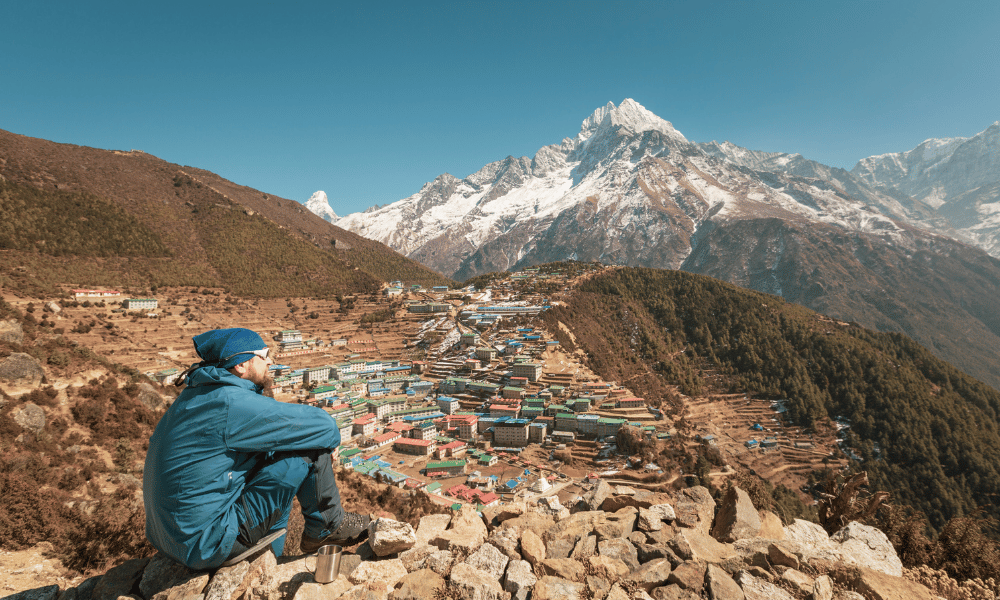
More severe symptoms can indicate serious conditions like High Altitude Pulmonary Edema (HAPE) or High Altitude Cerebral Edema (HACE). These symptoms can include:
Shortness of breath at rest
Inability to walk in a straight line, or to walk at all
Decreasing mental function or consciousness
Cough, possibly with pink frothy sputum
If you or anyone in your group experiences these symptoms, it is a medical emergency. You should descend to a lower altitude immediately and seek medical help.
If you or a member of your group starts showing symptoms of altitude sickness, follow these steps:
Do Not Ascend: If symptoms are mild, do not go any higher. It may be possible for the symptoms to go away after a day or two of rest at the same altitude.
Descend If Necessary: If symptoms persist or get worse after a day or two of rest at the same altitude, descend immediately. Delay in descending can lead to serious, life-threatening conditions.
Seek Medical Attention: If symptoms are severe, descend immediately and arrange for medical help. You should be accompanied by someone during descent.
Stay Hydrated: Dehydration can worsen the symptoms of altitude sickness, so ensure you're drinking enough fluids.
Rest and Refrain from Alcohol: Rest as much as possible and avoid alcohol, as it can worsen AMS symptoms.
Remember, the key to avoiding altitude sickness is a slow ascent, allowing your body time to acclimatize to higher altitudes. Listening to your body and responding quickly to any signs of AMS can ensure a successful and enjoyable trek to Everest Base Camp.
When preparing for your Everest Base Camp Trek, obtaining comprehensive travel insurance is not just a recommendation, it's a necessity. Treks at high altitudes pose certain risks, and having appropriate insurance coverage ensures that you are protected against unforeseen circumstances.

A comprehensive travel insurance policy for an Everest Base Camp trek should cover the following:
Altitude sickness and other health issues are more likely to occur at high elevations. Your insurance should pay for hospitalization, medical care, and emergency evacuation, which may need a helicopter rescue. You should carefully review the policy's specifications because not all insurance policies cover trekking to high elevations (Everest Base Camp is over 5,000 meters above sea level) or helicopter evacuation.
This coverage is for unexpected situations that may cause you to cancel your trip before you leave or cut your trip short. This can include personal illness or injury, a family emergency, or other unexpected events.
Baggage loss or delay coverage can reimburse you for personal belongings that are lost, stolen, or delayed. Given the remote locations of the trek, retrieving or replacing lost luggage can be challenging.
In the Everest area, erratic weather patterns frequently cause flight delays or cancellations. During the wait, additional lodging and food costs may be covered by insurance.
The cost of purchasing travel insurance is negligible compared to the peace of mind it provides. The freedom to concentrate on the adventure at hand comes from knowing that you are well-protected.
It's important to carefully study the policy terms before getting travel insurance to understand what is and isn't covered. For clarity, speak with the insurer directly if you have any questions.
Keep in mind, insurance is there for your protection, but the ultimate goal should always be to trek safely and responsibly to minimize any risk of accidents or health issues.
The Everest Base Camp trek takes you through remote regions of the Himalayas where access to medical facilities can be limited. Therefore, it's important to carry a basic first aid kit and essential medicines. Having these on hand can treat minor injuries and illnesses and can be crucial while waiting for professional medical help in case of more serious conditions.
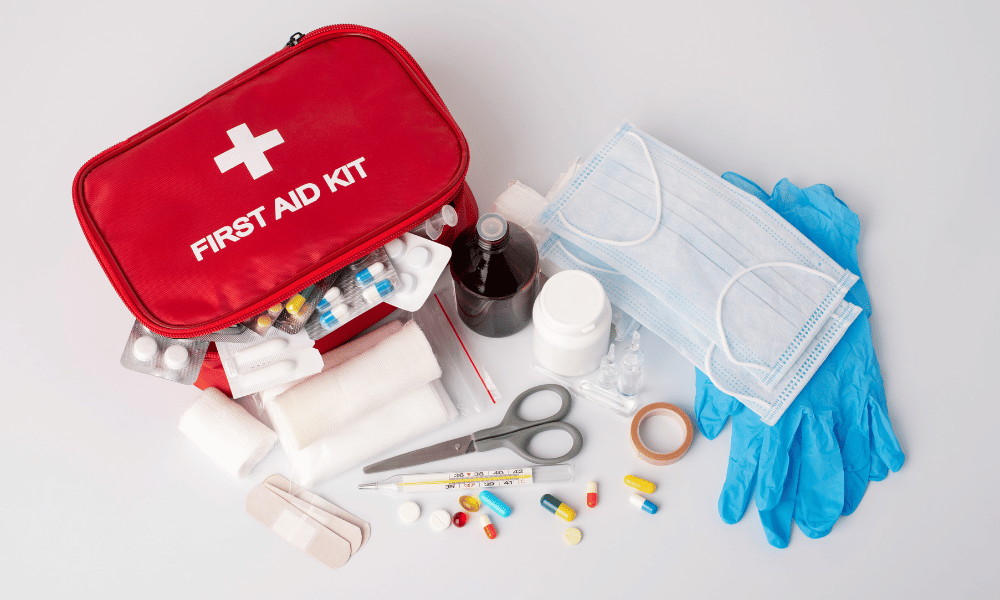
Here are some essentials your first aid kit should include:
Band-Aids and Blister Plasters: These are useful for covering small cuts, blisters, and abrasions.
Antiseptic Wipes or Cream: To clean wounds and prevent infection.
Tweezers: For removing splinters or other foreign objects from wounds.
Medical Tape: This can be used to secure bandages or gauze over wounds.
Pain Relief Tablets: Over-the-counter pain relief like ibuprofen can be used for headaches, muscle aches, or fever.
Rehydration Salts: These are important in case of diarrhea or dehydration.
In addition to a first aid kit, carrying essential medicines can be helpful. Some medications you might consider include:
Altitude Sickness Medication: Medications like Acetazolamide (Diamox) can be used to prevent and reduce the symptoms of altitude sickness. Always consult your doctor before your trip about whether these medicines are right for you.
Antibiotics: A course of antibiotics like Azithromycin or Ciprofloxacin can be useful in case of bacterial infections such as traveler's diarrhea.
Anti-Nausea Medication: This can help with nausea related to altitude sickness or other causes.
Water Purification Tablets: To ensure you always have access to safe drinking water.
Any Personal Medication: Don't forget to bring sufficient supplies of any personal medication you take regularly.
Despite its importance, a first aid kit and basic medications should never be used in place of seeking professional medical advice or treatment. Always seek advice from medical authorities on any health issues both before and after your walk. And bear in mind that prevention is frequently better than therapy; to maintain good health, trek carefully, acclimatize appropriately, remain hydrated, and eat a healthy diet.
A wonderful chance to become fully immersed in the breathtaking natural surroundings and the colorful local Sherpa culture is provided by a climb to Everest Base Camp. To leave as little of an environmental trace as possible, hikers should follow the "Leave No Trace" guidelines. This includes properly disposing of rubbish, showing respect for native plants and animals, and sticking to authorized pathways. It's important to comprehend and respect Sherpa traditions when it comes to the local culture. This includes dressing modestly, requesting consent before taking photos, and displaying respect at places of worship. Trekkers can support the sensitive Himalayan ecology and aid in the preservation of regional traditions and customs by respecting the environment and the local culture, making the experience educational and respectful for all.
Outdoor enthusiasts all throughout the world follow the "Leave No Trace" maxim to reduce their negative environmental effect. This is crucial in regions like the Everest Base Camp Trek, where an increase in trekkers' foot traffic can significantly impact the local ecology.
The 'Leave No Trace' principle includes seven key components:
Plan Ahead and Prepare: This involves understanding the regulations of the trek, planning your route, and considering what to bring along. Proper planning allows you to be self-sufficient and avoid making a negative impact on the environment and local communities.
Travel and Camp on Durable Surfaces: Stick to the established trails and avoid walking on undisturbed land or vegetation. When camping, choose sites that are already designated for this purpose.
Dispose of Waste Properly: Pack out all trash, leftover food, and litter. In some instances, you might also need to pack out your human waste.
Leave What You Find: Preserve the past by not touching cultural or historic structures and artifacts. Also, leave rocks, plants, and other natural objects as you found them for others to enjoy.
Minimize Campfire Impact: Campfires can cause long-lasting damage. Use a lightweight camp stove for cooking and a candle lantern for light. If you must have a fire, use established fire rings, keep fires small, and burn only sticks from the ground that can be broken by hand.
Respect Wildlife: Observe wildlife from a distance. Do not feed animals or disturb them intentionally. Avoid wildlife during sensitive times: mating, nesting, raising young, or winter.
Be Considerate of Other Visitors: Respect other visitors and protect the quality of their experience. This includes keeping noise levels down and respecting unspoiled natural experiences.
By practicing these principles, trekkers can minimize their environmental footprint, helping to keep the Everest region pristine and beautiful for future generations to enjoy. It's our responsibility as visitors to these natural spaces to ensure we're leaving them in the same, if not better, condition than we found them.
Trekking in the Everest region provides you the chance to fully experience the Sherpa people's rich and varied culture. This excursion is both physically demanding and culturally enlightening because to their generous welcome and distinctive combination of Tibetan Buddhist heritage. However, keep in mind that you are a visitor at their house and that it is crucial to respect their traditions and customs.
Here are some ways to show respect for the local culture:
Learning about Sherpa customs before your journey can help avoid unintentional disrespect. For example, it's a local custom to pass chortens, mani stones, and other religious monuments on your left. Also, if you're offered food or drink, it's polite to accept, even if you only take a small amount.
While trekking, it's important to dress modestly to respect local sensitivities. This typically means avoiding revealing clothing. When visiting monasteries or other religious sites, it's especially important to cover your shoulders and knees.
Sherpa people are generally welcoming, and many don't mind being photographed. However, it's respectful to ask for permission first. This also applies when photographing religious sites or ceremonies.
The Everest region is dotted with monasteries, chortens, prayer wheels, and mani stones. It's important to show respect at these sites. This includes removing your shoes when entering a monastery, not touching sacred objects, and turning prayer wheels in a clockwise direction.
Respecting the local culture also involves taking care of the environment. Following the Leave No Trace principles, as mentioned earlier, is a significant part of this.
By respecting local customs and traditions, you'll gain a deeper understanding of the Sherpa culture, enriching your overall experience of the Everest Base Camp trek. Remember, your trek is not just about the physical journey, but it's also a cultural journey into the heart of the Sherpa homeland.
An exciting trip, the Everest Base Camp trek provides an unrivaled fusion of magnificent high-altitude scenery, colorful culture, and self-actualization. Not only will you see the highest mountain in the world as you travel into the heart of the gorgeous Himalayas, but you'll also get a look of the tough Sherpa culture that inhabits this harsh yet beautiful region.
In this guide, we've covered essential tips that you should keep in mind as you plan and undertake this journey:
Preparing for the trek through physical fitness training and thorough planning.
Acclimatizing properly to minimize the risk of altitude sickness.
Packing wisely, remembering that every additional item is a weight you'll carry for days on end.
Staying hydrated and eating well throughout the trek.
Pacing yourself and making the journey at your own rhythm.
Enlisting the help of local guides and porters not just for safety and comfort, but also to enrich your trekking experience.
Being aware of altitude sickness symptoms and the actions to take if they occur.
Ensuring you have comprehensive travel insurance.
Carrying a basic first aid kit and essential medicines.
Adhering to the 'Leave No Trace' principles and respecting local customs and traditions.
Above all, keep in mind to enjoy the adventure itself, even if reaching Everest Base Camp will be a wonderful accomplishment. This walk is certainly a life-altering event since each day provides fresh landscapes, interactions, and difficulties.
We send our best wishes for safe travels, bright skies, and amazing experiences as you set out on your once-in-a-lifetime trip. May each step you take in Everest's shadow carry you to greater heights within yourself. A happy trek!
You ought to be reasonably fit and in excellent physical condition. The journey entails strenuous daily trekking at a high altitude. It is strongly advised to begin a regular workout regimen that combines aerobic, strength training, and trekking many months before the expedition.
Altitude sickness can be avoided with proper acclimatization. It's important to ascend gradually so that your body has time to get used to the thinner air. Keeping hydrated, eating healthfully, and sleeping sufficiently can all be beneficial.
Good hiking boots, warm, water-resistant clothes, hats, sunglasses, sunscreen, refilled water bottles, headlamps, and basic first aid kits are essentials. Additionally, you should carry any personal medications and pills for purifying water.
Keeping hydrated is important for preventing altitude sickness. Aim to drink at least 3-4 liters of water per day.
Although it is possible to hike without a guide, it is strongly advised. In addition to ensuring your safety, a guide will make your trekking experience better thanks to their familiarity with the region, its traditions, and culture.
It's important to alert your guide or a trekking companion right away if you have any symptoms such as headache, dizziness, shortness of breath, or nausea. In many cases, descending to a lower altitude is the preferred course of action.
The Everest Base Camp trip is difficult and isolated, making travel insurance that covers high altitude hiking and emergency evacuation vital.
To give your body time to acclimate to the altitude, try to maintain a modest and steady pace. Always keep in mind that it's not a race and that hurrying might cause altitude sickness. Enjoying the journey is more vital than concentrating only on getting there.